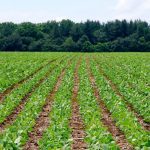Tag Archives Science Notes

To save bees, focus first on habitat, then pesticides: scientists
Science Notes: A recent study indicates habitat loss is a bigger factor than pesticide exposure when it comes to bee diversity

Slow-growth diet before breeding offers better long-range health in pigs
Science Notes: Researchers looking for more ways to improve sow longevity

Satellite images of plants’ fluorescence can predict crop yields
Science Notes: Information could help make policy decisions, establishing crop insurance, even forecast areas of poverty

Plant sensors could act as an early warning system for farmers
Science Notes:

Breeding more resilient soybeans may come down to test site selection
Science Notes: New maps aim to help breeders strategize placement

Discovery of amino acid unveils how light makes plants open
Science Notes: Amino acid plays a broader role in plant physiology than originally thought

New study is first step in predicting carbon emissions
Science Notes: Researchers develop process that is 10,000 times faster than current systems

Researchers use metabolic model to study temperature stress on corn
Science Notes: Fungus could alleviate corn stress

What if cows could talk?
Science Notes: Of particular interest is how cows communicate stress

Microbes could help reduce the need for chemical fertilizers
Science Notes: Coated bacteria improve germination rate of a variety of seeds
